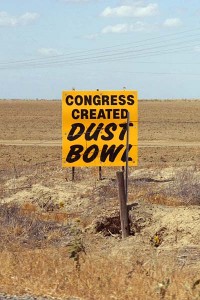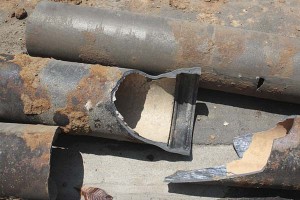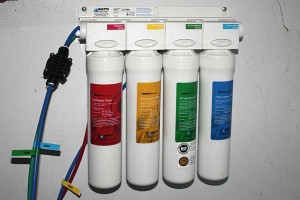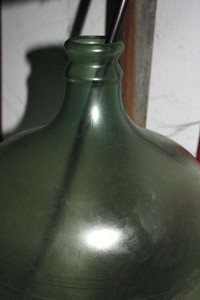It’s easy to obsess about something you don’t have enough of, and water in California is one of those things.
On my recent trip to Northern California it was hard not to notice the dozens of signs stuck along the side of the interstate like so many Fox News soundbites-on-a-stick. I can’t tell you all the details about our water-use wars, but it has something to do with ongoing drought, overpopulation and a mandate to return water to natural watercourses in attempt to keep some small fish from vanishing from the face of the earth forever. As cheap, plentiful water is shut off or diverted to the big cities with more political clout, it’s easy to see that some farmers aren’t happy.
Back home, we’ve been reminded that water doesn’t just magically fall from the sky in plentiful amounts. The cast-iron water lines that supply the neighborhood have been failing, and the old lines are being replaced with new, bright baby-blue water mains. All summer long the street out front has been a construction pit as they installed temporary supply lines, cut through pavement to remove the old problem pipe, installed the new lines and prepared to hook up the houses to the never-ending font of the life-giving fluid. They’ve said that the street will be a no-parking zone for the next six weeks. Feels like it’s been forever already.
Of course that water supply isn’t without limits. The city has been on a mandatory water-reduction program since June, and I was happy to see that city water use dropped 20% that month. But as the novelty of saving water wore off, July’s numbers fell to 12%.
I’ve been trying to do my part. Overall I feel pretty good about it, but I’ve found myself falling off the wagon a bit myself. My new offense is this little number, a reverse-osmosis purification system to improve the water quality I can offer a new little collection of carnivorous plants (more on that in a future post). A reality with almost all R/O systems is that producing one gallon of good water generates several gallons of waste. I knew that going into it, but the reality of it is pretty stunning.
But instead of following the installation instructions, which outline in detail how you send all the wastewater down the drain through the special pipe fittings the manufacturer thoughtfully supplies with the unit, I modified the installation to aim the waste stream into a water bottle. The rejected water ends up being a little saltier and grosser that what comes from the tap, but it’s still cleaner than the graywater we’re recycling from our showers and is perfectly good for watering the plants that aren’t among the chosen few.
Now that I’ve lived with this setup for a couple of weeks I’m finding that lugging around five gallon water bottles can be a bit of a chore. Maybe I’ll rig a way to divert the waste directly to the garden. But that’s a project that will have to wait. Fall planting season is coming up, as well as a pile of house projects. And then there’s that new collection of plants to play with…






I saw those signs, too. They looked too much like a political group had printed them up. Would’ve been more convincing if they’d been hand made, I think.
On the east side I saw a reservoir, Waugh Lake, that had been drained to let water flow back into Mono Lake. Now it’s back to being stream winding through the former lake bottom. Didn’t get a photo, but it’s an interesting image to remember.
I agree, it’s difficult to decide how to work with this problem. When I see the bright green golf courses and some public buildings with lawn nearby, I’m tempted to just let it go. But really, it’s feeling good about myself, and maybe setting an example.
(Clever setup with that filter. I had no idea that stuff takes so much water)
We saw those signs too last time we travelled to N. CA. Trying to be zeric down here. There must be a balance netween environmental issues & feeding the nation.
Very innovative of you to use the wastewater. I think it is great to reuse any water and it’s a shame water is in such supply out there.
I haven’t seen the signs, but I have seen tons of farms being watered with overhead water sprayers during the hottest part of the day. It’s hard for me to feel sorry for them, when we are converting to drip because we have to conserve and our water bills go up, but agriculture feels free to waste their subsidized water.
Reverse osmosis is incredibly wasteful. Unless you reuse the waste water like you are, eliminating the waste. Good job.
Yes water in California is very complicated. Late activist, Dorothy Green wrote a great book – very clear and easy to understand – on this topic called Managing Water- Avoiding Crisis in California. A non-profit that she founded, C-WIN (www.C-WIN.org), “promotes equitable and environmentally sensitive use of CA’s water.” On their website they point out that:
“California grows half the fruits and vegetables for the entire nation and [it] uses about 80% of the developed water in the state. Clearly, prime agricultural land must be preserved to protect this vital industry.
However, about half the developed water is used to grow four low value, water intensive crops: cotton, rice, irrigated pasture and alfalfa. Cotton and rice are also heavily subsidized by the federal government. And federal subsidies guarantee to Central Valley farms $416 million a year or more of cheap water.”
Furthermore, agriculture represents only about 3% of the state’s economy. (Green, p. 235).
I am all for low-flush toilets and all other water conservation efforts, but until we address inequities in water distribution in the state and have an honest airing of policies toward agribusiness, all we do is literally a drop in the bucket.
Hate to add a comment on an old post, but you are the only person I’ve found that mentioned re-using the waste water from RO systems. When we had our culligan installed in our condo, we just routed the wastewater to the drain and didn’t think about it. When we bought our home (in Colorado), it didn’t have an easy access for the drain and I didn’t want to drill into the old cast iron pipes for the drain saddle, so I improvised as well.
Right now, the drain tube runs up through the sink to a 5 gallon plastic carboy. With 3 people using RO daily, we easily fill the 5 gallon jug, so it would overflow. Next, I had to cut out a portion of the top to add a nipple to run a 3/8 pipe for overflow draining.
In the summer, we’d dump the 5 gallon jug every other day on the plants outside, but when colder weather rolled in, we couldn’t use it outside or it’ll freeze. Now it has a pipe fitted with a pump for siphoning out the water to use as a spray/rinser for pre-cleaning dishes.
We’d love to set up a greywater exhaust system down the road, but our setup for now does just fine.
Glad someone else out there is doing their part too.